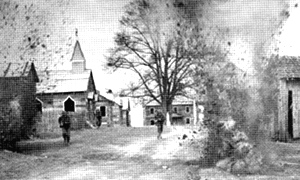
Camp Forrest
Camp Forrest, at Tullahoma, was one of the largest U.S. Army training bases during World War II. The camp served as a training facility for eleven infantry divisions, two battalions of Rangers, numerous medical and supply units, and a number of Army Air Corps personnel. In addition, the camp provided logistical support for the massive Tennessee Maneuvers conducted at intervals from 1941 through early 1945. The camp also employed thousands of civilians in various support roles and housed German prisoners of war.
In 1940 the United States began limited preparations for war and established Camp Forrest as a training facility for draftees. The projected $13 million facility was expected to cover forty thousand acres; eventually Camp Forrest cost $36 million and covered seventy-eight thousand acres. The Hardaway Construction Company of Columbus, Georgia, and the Creighton Construction Company of Nashville formed a temporary partnership to build the thirteen hundred buildings, the fifty-five miles of roads, and the five miles of railroad track that made up Camp Forrest. Over 20,000 people were employed in constructing the camp.
In March 1941 the camp was officially named for Confederate general Nathan Bedford Forrest. While some old arguments arose over General Forrest, more pressing concerns caused the past to be quickly forgotten. The Thirty-third Infantry Division of the Illinois National Guard and the Seventy-fifth Field Artillery Brigade of the Tennessee National Guard arrived later that month. After the attack on Pearl Harbor, two other infantry divisions, the Eightieth and the Eighth, were assigned to the post.
Housing at the induction and training center proved to be a recurring problem, and many soldiers bivouacked in tents during their assignment at the post. Camp Forrest employed 12,000 civilians who ran the post exchanges, operated the nine-thousand-square-foot laundry, performed maintenance on military vehicles, repaired tanks and artillery pieces, and staffed the induction center where some 250,000 young men received their initial physical exams for the army. Army trainees received instruction in house-to-house combat in the first village mock-up. The Second Ranger Battalion trained at the base and later won fame when they scaled the ninety-foot cliffs of Point-du-Hoc on D-Day.
Approximately 800 alien civilians were interned at Camp Forrest from January until November 1942, making the camp the first civilian internment camp in the nation. Prisoners of war replaced the civilian internees in 1943, and by the end of the war just over 24,000 members of the Wehrmacht were under guard at the facility.
After the D-Day invasion of France in June 1944, training at Camp Forrest was reduced drastically. The camp was declared “surplus” in September 1945 and given “inactive” status in February 1946. The War Assets Corporation sold off the buildings for lumber, and all equipment, from machine shops to kitchen utensils, was auctioned, although the state retained the land. Today the Arnold Engineering Development Center of the United States Air Force occupies the site. Only a few overgrown concrete foundations remain of Camp Forrest.



